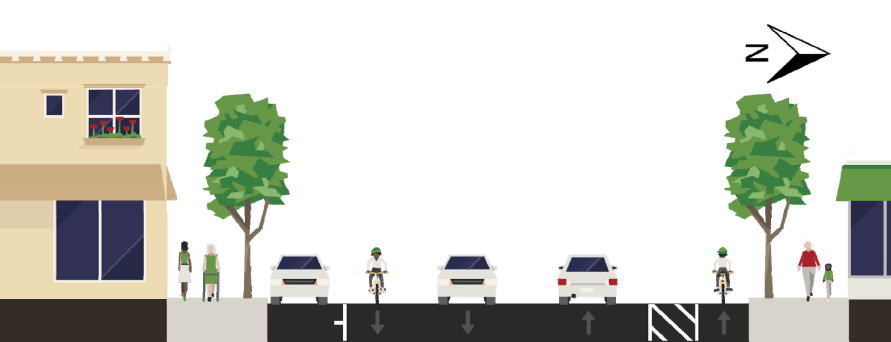Now’s the Time to Get DPW to Design the Safest Possible 29th Ave Bike Lane

The Department of Public Works wants to add two pieces to the growing list of bike infrastructure projects in Denver: a partially buffered bike lane on West 29th Avenue in the Highlands, and a neighborhood bikeway on West 35th Avenue to complement it. While the initial plans boast some solid elements, they could also go a lot farther to create a safe street for cycling — and now is the time to push for those improvements.
DPW staff presented the concept last night at a neighborhood meeting in the Highlands.
Refreshingly, the proposal calls for transferring street space from car lanes and parking to create bike lanes on each side of West 29th Avenue stretching from Umatilla to Yates, or about two miles. But only the westbound segment from Federal to Zuni will have a buffer to create separation between bike traffic and car traffic, and physical protection for cyclists is nowhere to be found.
A protected bike lane with bollards is not out of the question, DPW officials said, but was not considered in the original 2011 Denver Moves plan.
“When we did Denver Moves, protected bike lanes weren’t part of the lexicon, so we’re going through that to see what might work now,” said Emily Snyder, the city’s bicycle and pedestrian project manager. “Certainly there’s an option for vertical treatment. It’s not out of the question.”

Rachael Bronson, the city’s bike planner, said visually narrowing the street will hopefully lead to slower speeds. While Senior City Planner Dan Raine said there are currently no plans to lower the posted 30 mph speed limit, DPW is collecting traffic data to decide if it’s necessary.
At the approach to some intersections, the plan calls for the bike lanes to give way to sharrows. The fact that these stencils don’t provide much in the way of separation from traffic was not lost on Raine, who told the crowd, “A sharrow by itself is not a bike facility.”
With the exception of a few Highland residents concerned over the loss of car space, most people welcomed the bike lanes and asked for more from the city when it comes to bike infrastructure. One resident recalled helping a man on a bike who was on his back after a driver took him out.
“This was a terrible day for those people and it still haunts me,” he said. “I think it’s really critical that we get this infrastructure, and educate bicyclists and motorists.”
The West 35th Avenue bikeway, a collection of nearby streets that will cater to bikes and pedestrians by adding traffic calming elements, is meant to augment the bike lane. Curb extensions, turn restrictions for cars, bike signals and chicanes are all on the table.
These are malleable project in the midst of the public process. Officials held the meeting to receive feedback and ostensibly implement some of those ideas into the final design. DPW wants Denver’s bike/ped mode share — the percentage of total trips taken on bikes and on foot — to reach 15 percent by 2020. The best way to achieve that goal is by building infrastructure that makes riding on the street safe and comfortable for every skill level.
A partially buffered bike lane won’t entice most people to bike nearly as much as a fully protected lane would. The 29th Avenue corridor is a critical east-west connection that could eventually link neighborhoods within Denver and connect the city to the rest of the region. DPW wants to hear from residents to inform the process, and if enough people act now, they can make this project much safer and more effective.


